If you’ve been following along, you know that we were making our way down the East Coast of the US via inland waterways. There are several reasons for this. Namely, safety, shaking down the boat, and the fact that we are new to almost everything about this life.
By the time we got to Beaufort (pronounced bo-furt), NC, we had more confidence in the boat and more experience with her in sailing and motoring conditions. We had a few repairs to continue south, and as we finished them, a good weather window opened for us to do a coastal passage.
Wednesday, December 20, 2023
With the repairs complete, we evaluated routes to continue our southbound journey. Looking at the ICW route, we determined we could make it to the Wilmington, NC area in 2 days, but the tides were not in our favor. Next, we checked the weather and found we might have a window to do a 70-nautical mile coastal hop. Because our confidence in translating a weather forecast into actual sailing conditions was low (newbs!), we engaged Chris Parker’s Marine Weather Service, a well-regarded weather routing service in the cruising community, in our planning.
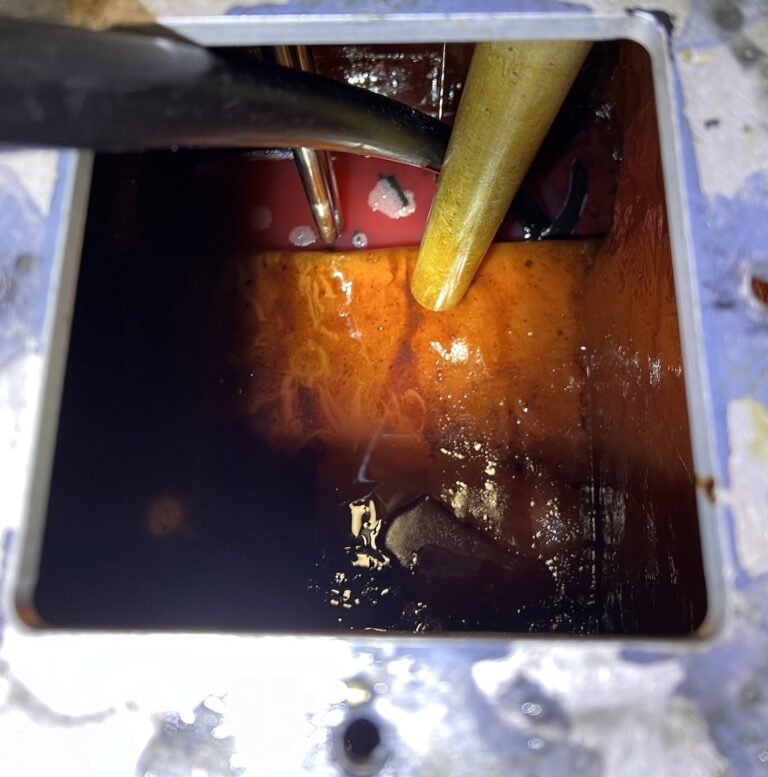
Thursday, December 21, 2023: Winter Solstice
At 9am, Chris Parker reports a good weather window for Friday-Saturday. He described the conditions as “benign,” which appealed to our desire to make our first ocean passage uneventful. Additionally, he recommended taking advantage of the longer window and sailing overnight to Charleston, skipping Wilmington. Good idea!
We revisited the weather reports and our passage plan and seriously considered this overnight passage. What would it take to make it work? The boat was ready with only a few pre-departure tasks (e.g., basic provisioning run, refilling water tanks, etc.).
Reconnecting with our mentors at Sailing Totem, they confirmed this was an excellent window for significant southbound progress and getting through some firsts. Additionally, Jamie recommended options for setting up the boat for the downwind sailing conditions. It was all coming together.
Of course, it’s the shortest day of the year. Leave it to us to pick the day with the least daylight to prep for a significant milestone passage.
Charlie worked on rigging for the boom preventer and the spinnaker pole to support a wing-on-wing configuration for sailing. I (Pinky) solidified the passage plan, wrote the float plan, made a grocery list, and secured all the interior bits, knowing it would be a rolly ride.
Before sunset, we motored out of the inlet to get a track for our pre-dawn departure in the dark. This was a great tip from Totem because we knew the Beaufort inlet would be tricky at night, and we planned to leave at 6am (sunrise was around 7am). During this short sunset cruise, we got to shake down the engine repairs and see some dolphins. Win-win! It feels so right to be prepping to go sailing in the ocean!
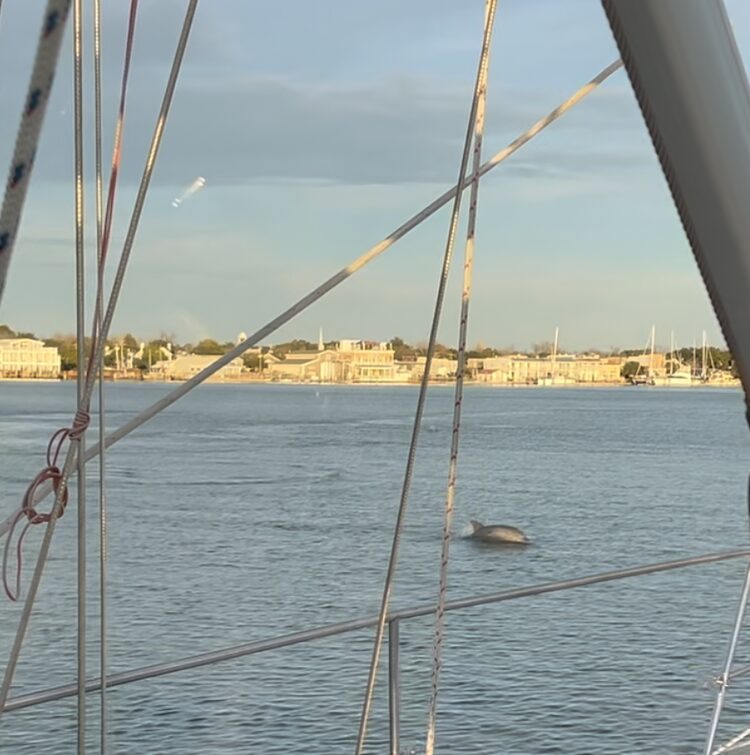
Friday, December 22, 2023
5am alarm goes off, and coffee always comes first. I do a quick meditation as my mindfulness practice is a primary tool in navigating the stressful parts of this journey. Next are the final pre-departure checks, including attaching our jack lines, which are safety lines that we clip ourselves into to make sure we stay on the boat when we’re on deck.
At 6:20am, we were finally off the dock. It’s dark. The moon set a few hours ago, and only the lights of the fishing facilities in Beaufort light our way out. We’re excited and nervous.
We followed our track from the previous day and beat the commercial traffic out of the inlet, making our exit stress-free. We witnessed a beautifully calm sunrise over the Atlantic.
The wind blew from the north at about 8 knots, which wasn’t enough for our sail plan downwind, so we continued motoring. We hoped to get more wind as we got further from the coast. Having so much space to maneuver after being in the confines of the ICW felt terrific!
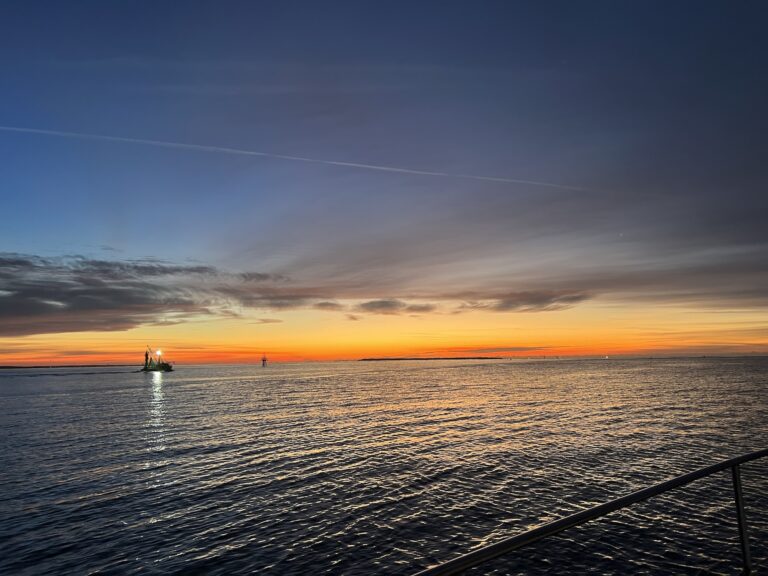
Around 12pm, we decided to put the sails up and see how our new downwind setup worked. Charlie had rigged the preventer on the port side and the spinnaker pole topping lift on the starboard side, planning to be on a starboard tack. We turned off the motor (which was running great) to see how Loka would sail on the rolly seas of the North Atlantic.
Using our first wing-on-wing configuration, we got 5.5knots (~5mph) of speed with 8-10knots of wind, which had us already rethinking our setup. We needed to gybe the boat (turn the butt of the boat through the wind) to make better progress on our desired route. But we had yet to practice moving the pole from one tack to another, and I felt too seasick to attempt the maneuver. While sailing is slower, we had to make a minimum average speed to get to our destination before max currents and before sunset. We had enough buffer time to continue on and see how our situation evolved, so we enjoyed the sail and rested.
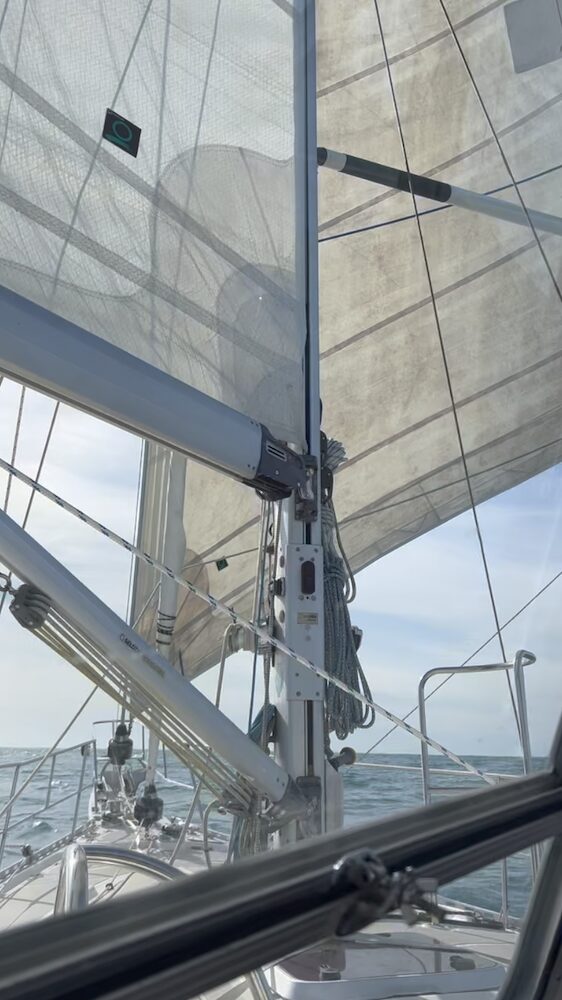
After about an hour of sailing slowly (~5knots), we decided to turn the motor back on and get moving to hit our 6.5knot average speed target. We hoped there would be some good sailing soon. We furled the genoa, lashed the spinnaker pole to the deck, and tidied the lines. We left the mainsail up to act as a wind brake because the rolly swell on our stern made the boat rock and roll. This brake mechanism effectively eased some of the “rock and roll” motion, making our ride more comfortable.
That said, I did get seasick. It was not the kind of debilitating seasickness that you might imagine. I used several available remedies so I didn’t feel overwhelmed by the seasickness. It was much more of an annoying thing that would come and go. I’ll write another post about how I managed through this, but Charlie and I discussed it throughout the journey. We agreed to a new rule: vomit in the head or a barf bag. Puking over the rail is not worth the risk of falling off the boat. Additionally, we had bailout points (see previously planned Masonboro route), so I didn’t have to be miserable if I wanted us to stop early. I opted to continue.
We took turns throughout the day, napping and keeping watch on a loose schedule, knowing we had our first overnight watch sequence to cover. Despite periodically feeling queezy, I kept all my watches. I puked only twice during the 30-hour journey.
Around 5:30pm, Charlie made dinner, which was a pre-made lasagna we picked up at the grocery store. This was a great comfort food on our first long journey, and it was easy to stick in the oven instead of attempting to prepare anything with the boat rolling all over the place.
We then started our night watch regimen of 3 hours on/3 hours off and included the following rules:
- If you need to wake the other person up, do it. Do not hesitate to ask for help just because they’re sleeping.
- Dusk-to-dawn: PFDs and clipped-in are required, even if you’re sitting in the cockpit.
- No going out on deck without the other person up.
This worked well for us as a first attempt. Three hours of sleep is enough to get some rest and is short enough not to be troublesome for the person on watch.
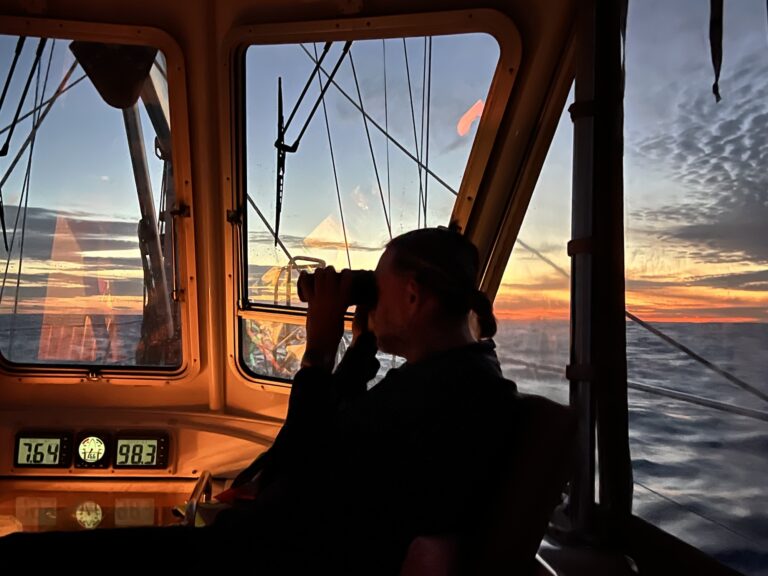
We continued motoring through the night, getting glimpses of stars and the moon through the cloud cover, which crept in just before sundown.
The craziest thing about being on the ocean, with no land in sight, is that you lose perspective on the sky, and everything in it feels so close you can touch it. The clouds and stars felt just out of reach instead of feeling a million miles away. I suspect that’s because we have no frame of reference since no buildings or trees are around. Oddly, I felt the least seasick during this time. One theory is my body didn’t have as much dissonance in the rolling vs. the horizon, or the sea state shifted just enough. Who knows, but I’m glad it was an uneventful overnight.
Saturday, December 23, 2023
As my last night shift ended at 6:15am, the wind appeared to pick up and came from a good angle (on our starboard 120º), meaning we could sail! As Charlie blearily came up to relieve me, I suggested setting the sails and asked if he wanted help before I went to bed. He declined my offer, so I went to crash. Not long after heading down, I heard the motor cut off and knew we were sailing. How glorious to be sailing on the Atlantic in our boat!
Around 9am, I got up from my restless rest and needed to eat something as my tummy was upset. I even took a vomit bag into the cockpit with me, not feeling very optimistic. I started snacking and took the helm to alleviate the conflicts of my inner ear. Charlie went down below to make French press coffee for the first time while underway.
Sure enough, I started to feel better. The sun was shining, and we were sailing! I didn’t need to use my vomit bag after all. And the cockpit coffee was some of the best we’ve had since moving onto the boat.
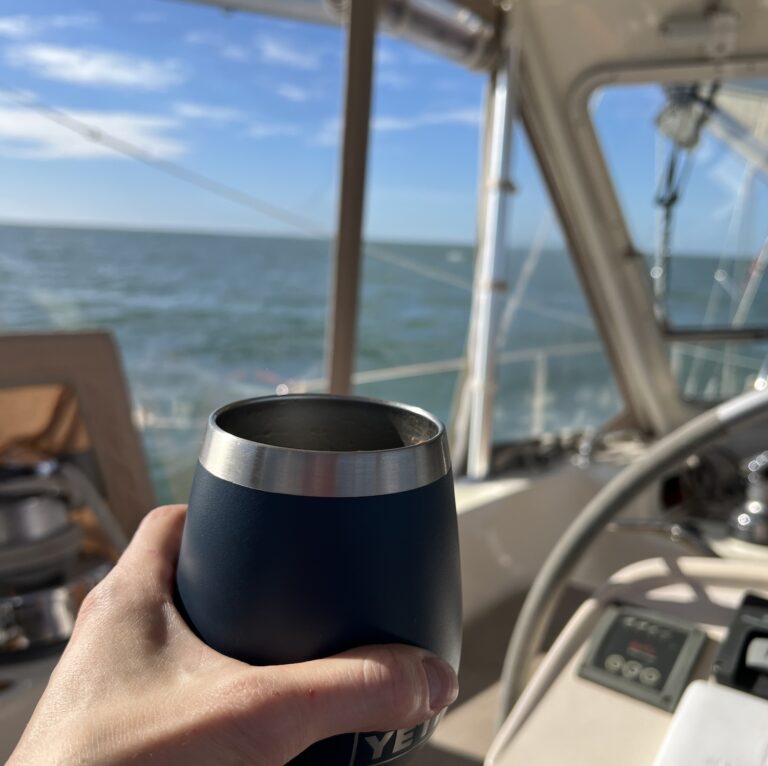
Around 10:30am, we began our approach into Charleston Harbour. As we approached the jetties, we recalled that it had been only a year ago (Dec 2022) that we had traversed this harbor for our ASA 103 & 104 sailing classes. Ah, sweet memories! Especially since I got wicked seasick on one of those journeys, and we had to turn back because the sea state was too rough.
At 11:30am, we sailed into the harbor under the power of the wind. We dodged commercial and recreational traffic, recalling our knowledge of the port, including the position of the range lights, Fort Sumter, and the cruise ship landing.
It was a triumphant return to a port where we had sailed someone else’s boat, and now we were sailing our home into port.
In preparation for anchoring, we found a spot to drop our sails and start the motor. We arrived at our destination at 1:30pm (13:30 for you military-time, friends) and set our anchor. We basked in the glory of the journey and planned our next adventure: a dinghy ride to Charleston City Dock to get an Uber to have a celebratory dinner in downtown Charleston.
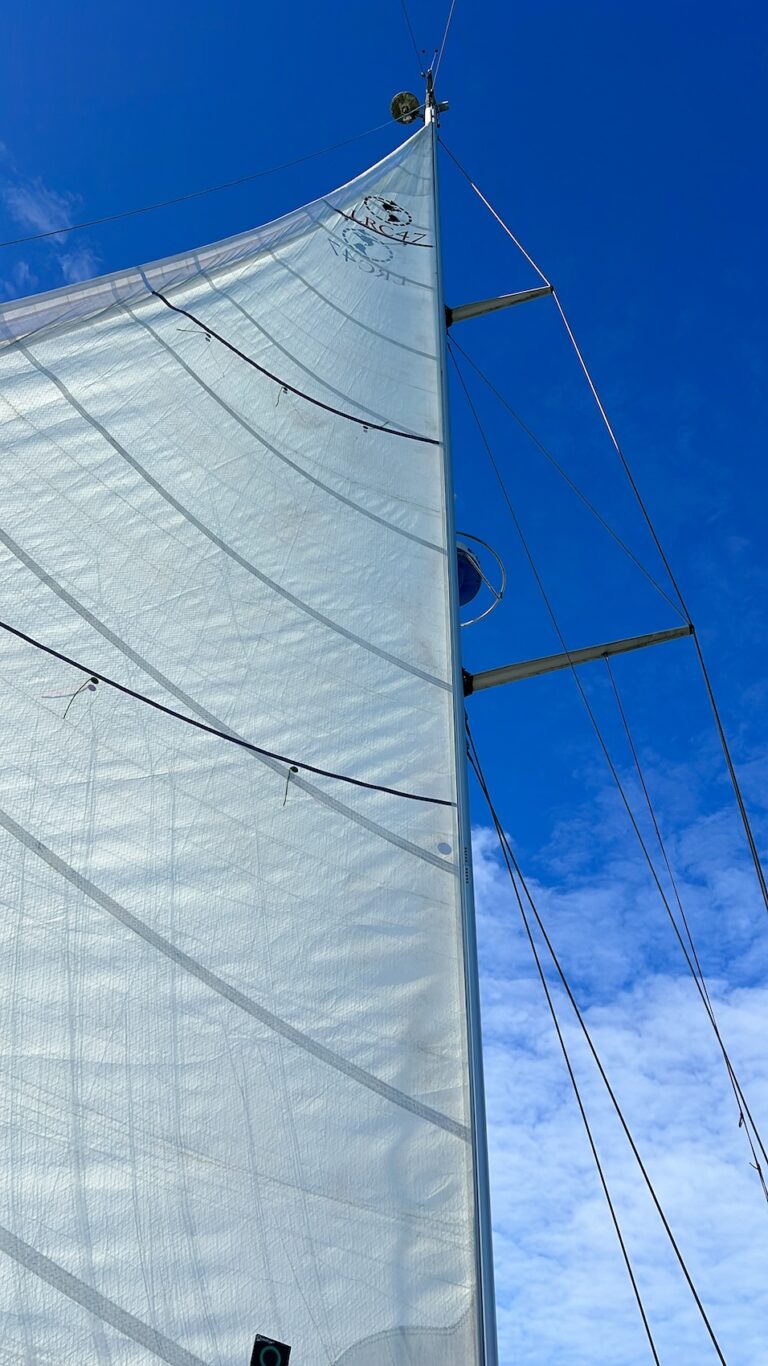
Debrief and Conclusions
We had a blast. Despite being seasick, I want to go again. We wish we could’ve sailed more, and we’re motivated to revise our genoa pole and boom preventer setup. We need to work our process for gybing with the pole out because it requires going up to the mast and working various lines. We got snacks right, and we enjoyed the sailing. The watched schedule worked well. Sleeping in the forward berth (instead of on the settee) worked well since the noise of the motor wasn’t as loud in that forward cabin.
I have more seasickness remedies to try, and there are conditions in which I don’t get debilitatingly sick. Everyone gets seasick. I’m not alone in this journey, and I’m told that the more I push my limits, the higher my tolerance will be. As long as I can keep it to “manageable,” I’m in to sail the ocean some more.
Sailing was glorious. It’s one of the reasons we’re embarking on this adventure. Traveling to cool places like Charleston is another reason, and getting to spend Christmas in Charleston was a special gift that we could not have planned. We’re excited about the upcoming passages, and we thank you for reading this far!
Journey stats:
- Distance: 217 nautical miles
- Average Speed: 7 knots
- Duration: 30 hours 20 minutes
- Pods of dolphins: 2
- Sunrises: 2
- Sunsets: 1
- Lessons: loads and loads!
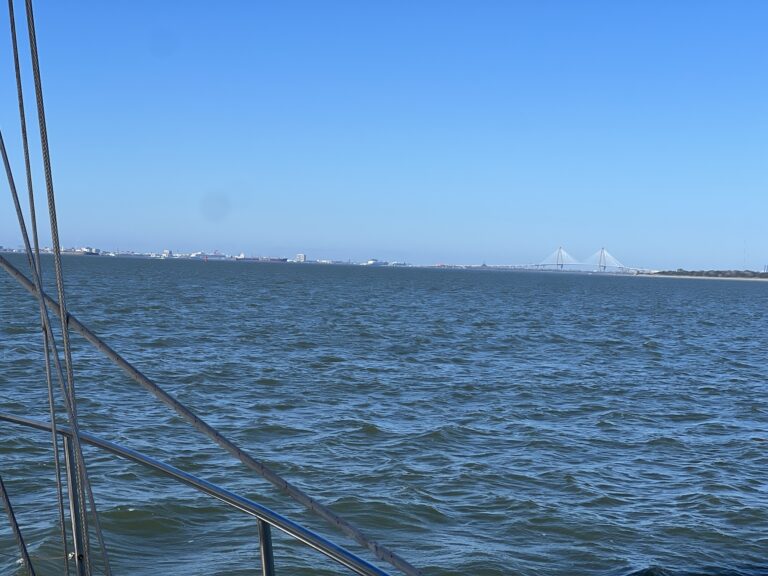
Discover more from SV Loka
Subscribe to get the latest posts sent to your email.
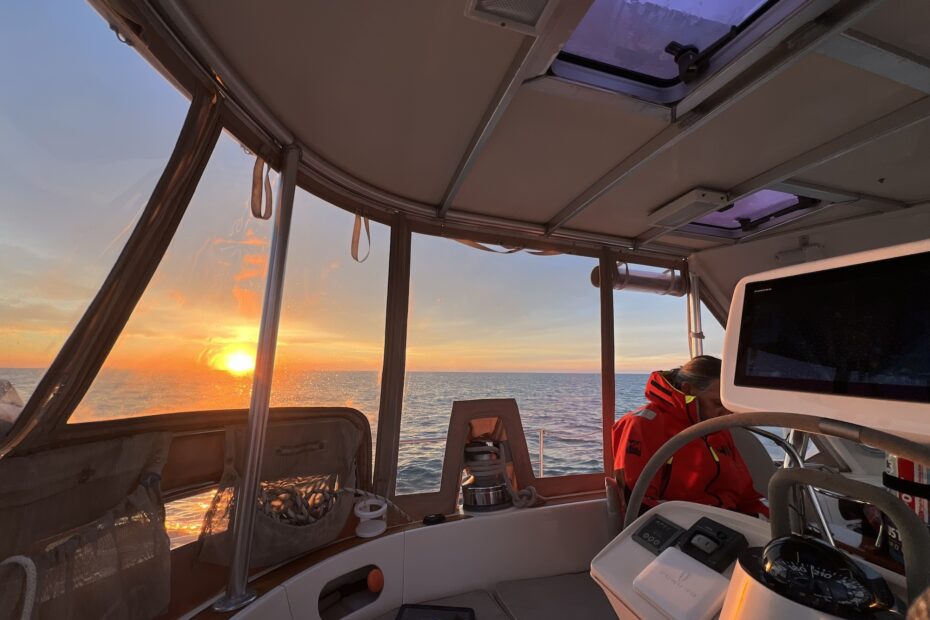
Congratulations on a successful first overnight passage!! So excited for you both 😊 We will hopefully 🤞 be doing our first overnight soon so loved reading about your journey! Hope you are enjoying your time in Florida!
Thanks, Kim. We’re stoked to be moving and learning. We’ll see you soon!
Awesome!! Keep it up and hope to see you sailing into a Bahamian harbor soon.
What a great account of this leg of your journey! I know little about sailing — I’m too lazy to be a sailor —but I suspect I’ll learn as I keep reading future posts.
As for motion sickness, I’m sure you’re trying all kinds of remedies. Add ”Seabands” to your list. They are elasticized wristbands with a pressure point that, when properly positions, helps relieve nausea by applying pressure to just the right place. These things work great for me and I always have a pair of them on board. (They also work for the nausea that I have experienced with migraine headaches in the past.) I’ve also found that the more you sail and the more you experience the motion of the water, the less likely you are to become sick. I used to get motion sickness when I first learned how to fly and it soon wore off. It’s because I was a pilot and couldn’t take medication that I turned to something like seabands to help when I needed it. You can find them in most major pharmacy chains. Be sure to buy that brand with the elastic; I can’t imagine the strap on being as good.
I’m heading north now; how far south in Florida are you going? I’ll be in Cocoa for the next two nights to see the SpaceX launch, then on to an anchorage north of there, then MarineLand and St. Augustine. I stay in the ICW. My little boat was built to handle the ocean, but I wasn’t!
Safe travels! I hope we can meet up.
Thanks for the tips. I’ve got an electronic version of the seabands that I’ll write about soon. I’m looking forward to my continued adjustment to life on the water. 😄
Very proud of you. Excellent story. So happy to see your dreams come true. Keep up the debrief. Just wait. The sailing debrief for our channel will be up soon. Keep up the debrief as it’s so important for your learning. See you in the lower latitudes soon. As you know, I think she’s a great boat.
Thanks for all your support, John. Were grateful I for your the whole Ministry of Sailing team
I love your journey stats! You both are an example for those who like Larry and me who are getting a bit tired.
Thanks, you for sharing your motion sickness adventure. I need so much help. My motion sickness appeared after cancer treatments. Larry says, at least you are HERE to get sick. (men!)
Safe travels, Bon Journee.
XOX Robin
Pingback: South Carolina to Florida: Our Southbound Journey Continues – SV Loka
We miss you on land, but love your adventures and photos! Amazing!!!
Miss you, Pam (& family group)!!! Wouldn’t be here without your support.
Pingback: To the Bahamas: Our First Gulf Stream Crossing – SV Loka
Pingback: Great Harbour Cay, Berry Islands, Bahamas – SV Loka